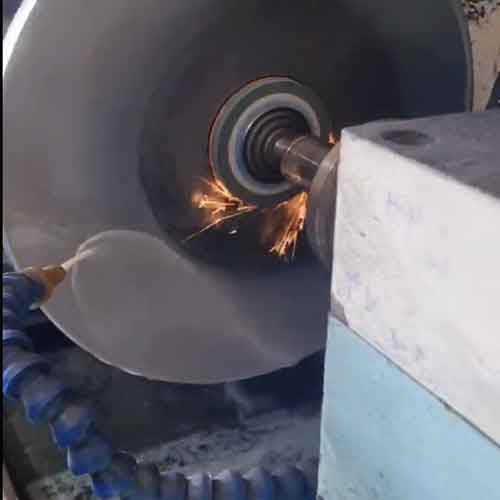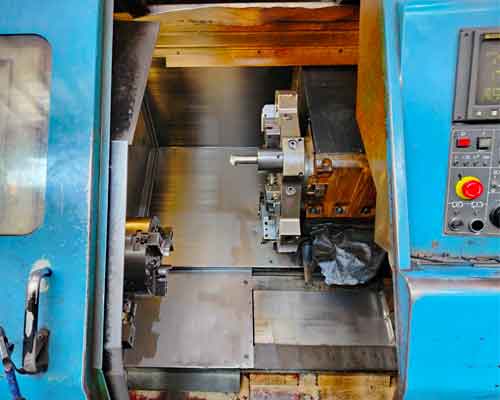Manufacturing Process of Rollers
Rollers are a critical component in pipe and profile production lines, as they guide and shape metal strips or tubes during forming processes. High-quality rollers ensure precision, stability, and durability, which directly affect the efficiency and output quality of the production line.
Design & Simulation
- In the first step, based on the drawing and specifications of the target pipe or profile, the shape, dimensions, and grooves of the rollers are designed.
- CAD software such as SolidWorks or AutoCAD, combined with Finite Element Analysis (FEA), is used to evaluate stresses, deformation levels, roll deflection, and operational stability.
- The design process must also consider factors such as thermal expansion, load distribution, service life, future repair or reconditioning options, and operating conditions of the production line.
Rough Machining
- The raw blank undergoes turning and milling operations to achieve the basic shape of the roller.
- The outer diameter, inner dimensions (if the roller is hollow), and preliminary grooves are created in this stage.
Stress Relieving
- A stress-relief heat treatment is performed to reduce residual stresses generated during machining and to prevent cracking in subsequent processes.
Heat Treatment
Rollers are subjected to quenching and tempering processes to achieve both high surface hardness and resistance to fracture.Accurate control of temperature and cooling rate is critical, especially for large-size rollers.

Final Machining & Groove Cutting
- After heat treatment, the rollers undergo precise machining to form the final grooves, curves, and dimensions according to the design.
- Tight dimensional and geometric tolerances must be maintained.
Grinding & Surface Finishing
- Roller surfaces are ground and polished to achieve the required smoothness and surface quality.
- For sensitive applications, mirror polishing is performed to prevent damage to the product surface.

8.Surface Coating / Surface Treatment
- To enhance wear and corrosion resistance, hard chrome plating is the most widely used method.
- For special applications, advanced coatings such as PVD, TiN, or ceramic coatings may be applied. In some cases, diffusion treatments such as nitriding are also performed.
Balancing
- Rollers must be both statically and dynamically balanced to operate without vibration at high speeds.
- Balancing may involve material removal or the addition of counterweights.
Inspection & Testing
- Non-destructive tests such as ultrasonic or magnetic particle inspection are carried out to verify internal soundness.
- Final dimensions are checked with precision instruments such as a CMM (Coordinate Measuring Machine).
- Surface hardness, coating quality, and roughness are also inspected.
Assembly & Installation
- The roller is mounted onto the shaft or machine frame and fixed in place using bearings, keys, or bolts.
- The roller’s position is then precisely adjusted relative to the other rollers and the machine axis.
Trial Run
- A trial run is conducted using actual sheet or profile material.
- The produced product is inspected for dimensional accuracy, straightness, and surface quality, and final adjustments are made if necessary.
Maintenance & Reconditioning
- During service life, rollers may suffer from wear or deformation due to continuous contact with the strip.
- Reconditioning processes such as re-grinding, re-coating, or replacement are performed as required.
FAQ:
- What materials are used for tube and profile production rollers?
Tube mill and profile forming rollers are typically made from high-alloy tool steels with excellent wear and heat resistance, such as Cr12MoV, SKD11, or D2.
After heat treatment (hardening and tempering), these steels achieve high surface hardness, excellent bending strength, and long service life under continuous production conditions.
- Are the rollers designed specifically for each profile type?
Yes. At Lotos Forming, every roller set is custom-designed based on the customer’s drawing, sheet thickness, and material type.
Using advanced CAD modeling and FEA (Finite Element Analysis) simulation, we ensure optimized forming, accurate force distribution, and smooth production without distortion or deformation.
- What is the service life of rollers in production lines?
The lifespan of rollers depends on several factors, including steel grade, surface coating, raw material quality, and line setup accuracy.
On average, hardened and hard-chrome-plated rollers have a service life of 2 to 5 years under normal working conditions — and even longer with proper maintenance and lubrication.
- How can worn rollers be reconditioned?
Worn or damaged rollers can be reconditioned to extend their life.
The process includes re-grinding the surface, correcting grooves, and reapplying coatings such as Hard Chrome Plating or Nitriding.
A professional reconditioning service can reduce replacement costs by up to 70% compared to new roller sets.
- What quality control tests are performed on rollers?
All rollers manufactured by Lotos Forming undergo dimensional inspection, surface hardness testing, and dynamic balancing.
When required, non-destructive tests (NDT) such as Ultrasonic Testing (UT) are carried out to detect any internal cracks or structural defects, ensuring complete product reliability.
- Does Lotos Forming provide roller reconditioning or redesign services?
Yes. The Engineering Department at Lotos Forming offers roller redesign, form correction, and reconditioning based on samples or technical drawings.
We also perform reverse engineering for older production lines, allowing customers to upgrade or replace roller sets without purchasing a completely new system.
- How long does it take to design and manufacture a complete roller set?
Production time depends on the number of forming stations and the complexity of the profile.
Typically, from design to final delivery, a complete roller set requires 3 to 6 working weeks.
For custom or high-volume projects, a detailed production schedule is provided in coordination with the customer.
